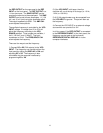15
going transitions of the reference input. This
mode triggers on a negative pulse train or on the
falling edges of a TTL type pulse train
(remembering that the input is ac coupled). The
pulse width must be greater than 1 µS.
Reference Mode
The REFERENCE MODE indicator toggles
between f and 2f whenever the MODE key is
pressed. When the MODE is f, the lock-in will
detect signals at the reference input frequency.
When the MODE is 2f, the lock-in detects signals
at twice the reference input frequency. In either
case, the reference oscillator has a maximum
frequency of 100 KHz, thus, when in the 2f mode,
the reference input frequency may not exceed 50
KHz.
Reference Display
The REFERENCE DIGITAL DISPLAY shows
either the reference oscillator frequency or phase
shift. The displayed parameter toggles between
the two whenever the SELECT key is pressed.
The appropriate scale indicator below the display
will be on. It is useful to check the frequency
display to verify that the lock-in has correctly
locked to your reference. The reference frequency
is measured to 1 part in 256 resolution at all
frequencies. The display reads .000 if there is no
reference input and 199.9 kHz if the input
frequency exceeds 105 kHz.
Phase Controls
The phase shift between the reference oscillator of
the lock-in and the reference input signal is set
using the four keys in the PHASE section. The
two keys below the FINE label increment the
phase setting in small amounts. A single key
press will change the phase by 0.025 degrees in
the desired direction. Holding the key down will
continue to change the phase with larger and
larger steps with the largest step being 10
degrees. The two 90° keys are used to change
the phase by 90 degree increments. The upper
key will add 90 degrees and the lower key will
subtract 90 degrees. Holding both keys down at
once sets the phase shift back to zero. The
REFERENCE DIGITAL DISPLAY automatically
displays the phase whenever any of the PHASE
keys are pressed. The phase ranges from -180
degrees to +180 degrees and is the phase delay
from the reference input signal.
Time Constant
There are two post demodulator low pass filters,
labeled PRE and POST. The PRE filter precedes
the POST filter in the output amplifier. Each filter
provides 6 dB/oct attenuation.
The PRE filter time constant ranges from 1 mS to
100 S and is selected by the two keys below the
PRE filter indicator LED's. Holding down either
key will advance the time constant four times a
second in the desired direction.
In many servo applications, no time constant is
needed. The SR530 may be modified to reduce
the output time constant to about 20 µS. Contact
the factory for details.
The POST filter time constant can be set to 1 S or
0.1 S, or can be removed altogether, NONE, using
the two keys below the ENBW indicators. When
set to NONE, the total attenuation is that of the
PRE filter, or 6 dB/oct. When the POST filter is 1
S or 0.1S, the total attenuation is 12 dB/oct for
frequency components beyond the larger of the
POST and PRE filter bandwidths (reciprocal time
constant).
Noise Measurements
When the DISPLAY is set to X NOISE Y NOISE,
none of the PRE and POST indicator LED's are
on. Instead, one of the two ENBW indicators will
be on, showing the Equivalent Noise Bandwidth of
the rms noise calculation. The ENBW is set using
the keys below the ENBW indicator LED's (same
keys as used to set the POST filter). The PRE
filter keys do nothing in this case. Pressing the
upper key when the bandwidth is already 1 Hz will
reset the rms noise average (output) to zero,
restarting the calculation. Likewise with pressing
the lower key when 10 Hz is already selected.
The noise is the rms deviation of the output within
a 1 or 10 Hz equivalent noise bandwidth about the
reference frequency. A dc output does not
contribute to the noise, the noise is determined
only by the ac 'wiggles' at the output. By
measuring the noise at different frequencies, the
frequency dependence of the noise density can be
found. This usually has the form of v
noise
~
1/f.
The noise computation assumes that the noise
has a Gaussian distribution (such as Johnson
noise). Since the computation takes many time
constants (reciprocal ENBW), the noise output


















